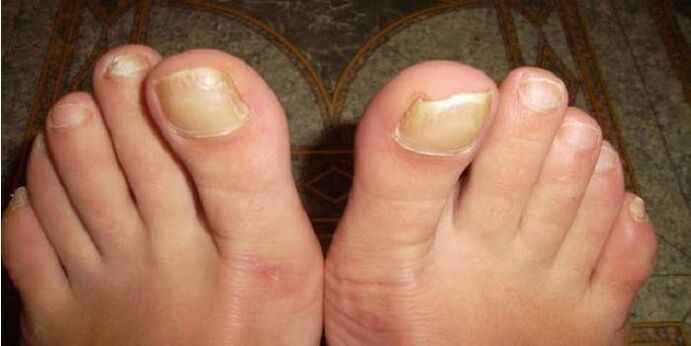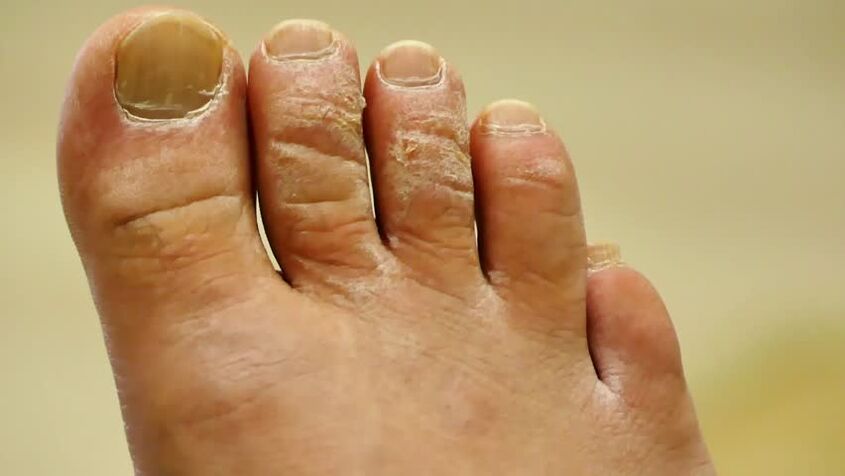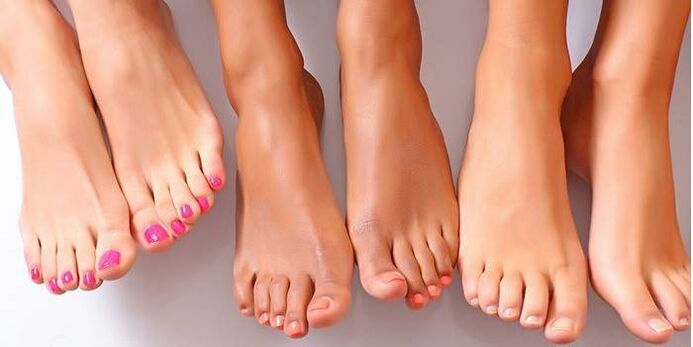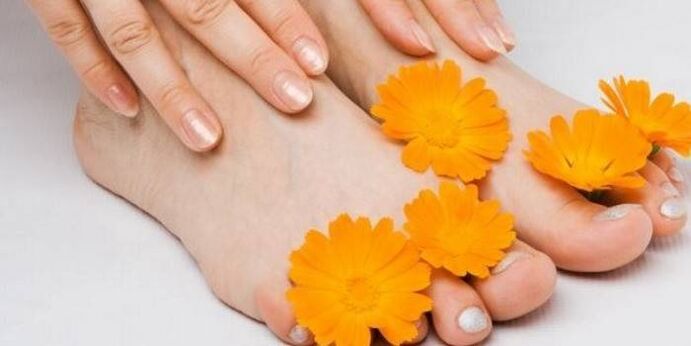A large number of fungal infections are difficult to treat. For this reason, the effectiveness of therapy against them is much higher in the early stages. To overcome this disease more quickly, you need to know how nail fungus starts. One often does not notice the first symptoms, which is a big mistake. Walking, the fungus not only significantly worsens the quality of life, but also causes serious complications in the form of complete loss of nail plates and even sepsis.
What is foot fungus
In medicine, fungi are understood as a group of diseases called mycoses. They are in second place after purulent lesions of the epidermis - pyoderma. Parasitic pathogenic microorganisms on a person's skin or nails, causing infections. In the first case, the disease is called dermatomycosis, and in the second, onychomycosis. There are other types of secreted fungal infections depending on the pathogen. There are many types of fungi. They are divided into anthropophilic (affecting humans) and zooanthropophilic (observed in humans and animals).
The reasons
The main risk factor for contracting a fungal infection is a weakened immune system. In this case, it is easier for pathogens to enter the body. Easily infected in public places, especially with high humidity and temperature, for example, swimming pools, gyms, saunas, steam rooms. Among the risk factors for fungal diseases are also:
- Flat feet;
- inadequate personal hygiene;
- circulatory disorders in the lower legs;
- increased sweating;
- frequent trauma to the skin;
- obesity.
This is a major cause of fungal infections. Common is the causative agent of the disease itself. Depending on the parasitic fungus, a person can develop the following types of infections:
- Epidermophytosis. It is observed when the skin and nails are exposed to anthropophilic fungi with dermatophytes (dermatomycetes) of three types: Trichophyton, Microsporum, Epidermophyton. You can get this infection through household items. The risk group includes older men, especially with excessive foot sweat.
- Trichophytosis. It is caused by the fungus trichophyton, which is highly contagious. Trichophytosis is also observed in children and adolescents. Workers bathing, showering, hot workshops are more vulnerable.
- Candidiasis. It is observed more rarely than other forms of fungal infections. Yeast fungi of the genus Candida are considered conditionally pathogenic, as they are activated when immunity is weakened.
- Rubromicosis. This is a type of ringworm caused by the fungus Trichophyton rubrum. Due to its high enzymatic activity, pathogens cause damage to the skin of the feet at large skin folds. Fluffy and long hair is less often affected. Rubromycosis accounts for 60-80% of all fungal infections of the feet.
- Onychomycosis of the feet. This is a fungal disease of the nail plate caused by various types of pathogenic fungi. One or more nails are affected. If the infection is not treated, then the plate is completely destroyed.

The route of infection
The chances of infection in children are higher, because their thin skin makes them more susceptible to microorganisms. Risk factors include a weakened immune system, problems with the nervous or endocrine system, the presence of chronic pathology and altered sweat composition. There are several ways to get a fungal infection. They belong to two main groups:
- Straight. Infection occurs through plants, soil, contact with sick people or animals.
- Indirect. In this case, you can be infected while using the personal belongings of the infected person or the items he or she uses.
Symptoms of fungus on the feet
A well -studied clinical picture of fungal infections helps identify them at an early stage. Damage to the nail structure and soft tissue can be seen at the location of the lesion with the naked eye. Common fungal symptoms are shown in the following list:
- the color of the nail plate changes to light yellow in the early stages, and then to yellow, brown, light green and even black;
- itchy sensation in the periungual zone;
- unpleasant smell;
- hyperkeratosis, i. e. thickening of the nail plate, or its thinning;
- change the shape of the free nail edges;
- peeling skin around the nail plate and in the interdigital space;
- calluses and calluses on the feet;
- brittleness of nails, collapse;
- redness of the skin around the nail plate.
Epidermophytosis and trichophytosis
This form of fungal infection occurs in a very similar way, which is why it is combined into one group of diseases. They are called "foot mycoses". Depending on its form, the infection appears with different symptoms. Often, patients have several types of fungus combined at once. For this reason, the division of fungi into forms is conditional:
- squamous, or scaly;
- dyshydrotic, which is accompanied by disorders of the sweat glands;
- intertrigious, in which a diaper rash is noted on the skin;
- hypertrophic, atrophic or normotrophic onychomycosis.
Forms of squamous foot fungus
The early stages of the fungus on the feet of this form are characterized by the defeat of only one foot. The infection will only be contracted later. The disease can be identified by the following symptoms:
- the appearance of reddish areas on the skin of the feet;
- in the future, this area begins to flake off (the affected area may have a different area);
- some patients experience itching.
The difficulty in diagnosing and treating the squamous form is that many patients are not worried about the symptoms. Therefore, they go to the doctor at an advanced stage. If the form of squamous fungal infection persists for a long time, then it can give rise to the appearance of dyshidrosis. These two forms are interrelated, so they often give rise to the appearance of each other.

Dyshidrotic form
This form is characterized by a course with changes in the period of remission and relapse. The first symptom is the appearance of bubbles in the arch of the foot (more often than one) - where it does not come into contact with the floor when walking. The size varies from 2 to 8 mm. Gradually, they began to merge, merging into one big one. Next, each bubble is opened, and in its place remains a superficial skin lesion - erosion.
In addition to the arch of the foot, its inner and outer lateral surfaces can also be infected. At the site of vesicle ulceration, large erosions remain, combined with diaper rash. Patients also complain of the following symptoms:
- pain and itching at the site of the lesion;
- after the erosion dries, it begins to flake off, resulting in the formation of a squamous form;
- bacterial infections gradually merge, as the contents of the vesicles become cloudy, become purulent (in this case, antibiotics must be taken);
- at a later stage, the skin of the feet becomes red, swollen, the patient experiences severe pain and even fever.
Forms of intertrigue
Among all forms of trichophytosis and epidermophytosis, it is the most common. It grows on its own or against the background of a kind of squamous fungus. It is more often celebrated in the summer. In winter, there is a period of remission. The disease is prolonged and chronic. The beginning of the process can be seen between 4 to 5 toes, more rarely between 3 and 4. The first signs of intertrigious forms:
- cracks and massages on the skin with a whitish rim around it, formed by the exfoliating epidermis (the surface layer of the skin);
- itching and burning sensation at the site of the lesion;
- crying in the interdigital space;
- the appearance of erosive cracks in place, accompanied by severe pain syndrome.
As the disease progresses, the skin will disappear, as its protective function decreases. This increases the risk of streptococcal infection. It manifests itself as pustular inflammation, which is accompanied by swelling, redness and pain on the skin. Against this background, an increase in body temperature is observed. Patients complain of deterioration of general well -being.
Onychomycosis of the feet
The disease in 70-75% of cases affects 3 and 4 toes, more rarely - 1 and 5. Often, onychomycosis persists in the form of normotrophic form, in which the color of the nail turns yellow, and its integrity is preserved. If there is an infection with a fungal fungus, the infection develops against the background of other diseases. nails turn yellow, brown or black.
It is possible to detect onychomycosis at an early stage with spots and yellow streaks on the nail plate. Pathological changes were first observed near its free edge. Depending on the form of onychomycosis, it manifests itself in the following symptoms:
- Hypertrophic. It is accompanied by thickening and yellowing of the nail plate. It crumbles easily, and the skin underneath begins to peel off, becoming thick.
- Atropic. Instead, the nail plate becomes thinner. Rough skin is also exposed underneath.

Early stage treatment of fungus on the feet
In the early stages of infection, topical preparations are used in the form of ointments, gels, patches, solutions, varnishes, sprays, and liquids. They are effective by acting directly on the site of inflammation. For the interdigital space, gels and suspensions are more appropriate, and ointments for heel skin. The early stages of nail fungus are treated with varnishes and antifungal solutions.
If the disease has progressed, then systemic medication is needed. They are used as tablets and capsules. They destroy the infection from the inside out. In the early stages, the use of tablets and capsules was irrational because of the greater number of side effects compared to local agents. In addition to medications, it is important to adhere to hygiene rules. This must be done as follows:
- wear closed slippers, do not walk around the house barefoot;
- treat shoes 2 times a day with a special disinfectant;
- wash the patient's clothes separately from all other items;
- wash your feet daily, then treat with an antifungal agent;
- do wet cleaning in the room daily, ventilation;
- after bathing, rinse with hot water;
- change socks daily;
- after healing, discard the patient’s socks, towels, shoes, wipes and other items.
To prevent the possibility of recurrence of the disease, it is necessary to strengthen the immune system. For this, patients are given immunomodulators and vitamins. The basis of external and systemic therapy is antifungal drugs. When attaching a bacterial infection, antibacterial drugs are used. Sometimes antihistamines are prescribed to relieve allergies.
Remedy for foot fungus
Knowing what nail fungus is like in the early stages, you can see it earlier. This will ensure faster recovery. The effectiveness of therapy also depends on the right medication. There are many antifungal agents in the form of tablets, ointments, gels. To use drugs properly, you need to study their main features:
| Active ingredients | Mechanism of action |
Methods of use, effects |
Course of treatment |
Contraindications |
Naftifine hydrochloride |
Destroys the causative agent of foot mycoses, some bacteria. Has anti-inflammatory effects. |
Rub the cream or solution onto cleansed skin 2 times a day. |
2-4 weeks. |
Pregnancy, lactation, age up to 18 years. |
Natamycin |
Effective against all pathogens of foot mycoses. |
Apply the suspension or cream several times a day on the affected skin. |
Determined by a doctor. |
Sensitivity to product elements. |
Clotrimazole |
Many other antifungal agents have been synthesized based on this material. Clotrimazole has a broad spectrum of action. |
Apply on clean and dry skin 2-3 times a day. |
1-4 weeks + 3 more weeks after recovery. |
Hypersensitivity to clotrimazole. |
Econazole |
It is effective against many mycosis pathogens, including fungi and yeast -like fungi. |
Apply creams, lotions, solutions or aerosols 1-3 times a day on the skin of the feet. |
2-4 weeks. |
Pregnancy. |
Itraconazole |
Various activities against all fungal pathogens. |
2 capsules 2 times a day - with onychomycosis; 0. 1-0. 2 g 2 times a day - with foot mycosis. |
7 days, then a break of 3 weeks - with onychomycosis; 1-2 weeks - with foot mycosis. |
Pregnancy, lactation, concomitant use of midozolam, nisoldipine, ergot alkaloids. |
Sertaconazole |
Fungistatic and fungicidal action against candidal fungi and trichophytons. |
Apply a small amount of cream to the affected area twice a day. |
Up to 4 weeks. |
Pregnancy, lactation, hypersensitivity, children. |
Terbinafine |
Destroys candidiasis pathogens, trichophytos, emidermophytos. |
0. 25 g 1-2 times a day. |
6 weeks, with damage to the nail plate - 12 weeks. |
Kidney and liver dysfunction, malignant neoplasms, pregnancy, lactation, vascular disease of the legs. |
Fluconazole |
High activity against yeast fungi. |
150 mg weekly or 50 mg daily. |
6 weeks. |
Pregnancy, lactation, childhood. |
Griseofulvin |
Fungistatic effects on pathogenic fungi. |
16 mg per 1 kg of body weight daily in the first month of treatment; further in the same dose, but daily; in the third month according to the second scheme, until healthy nails grow back. Apply the ointment no more than 30 g per day. |
For tablets - 3 months, for ointments - 3 weeks. |
Liver and kidney dysfunction, decreased number of leukocytes in the blood, pregnancy, lactation, malignant tumors. |

People's method
Effective treatment even in the early stages of a fungal infection cannot be done without medication. They are the main therapy. The traditional method is only used as an additional method. Although alternative medicines are relatively safe, you should consult a doctor before using them. He will suggest the following alternative methods to treat fungal infections:
- Take the amount of oak bark, verbena, calendula inflorescences, dried blackberries. From the resulting mixture, put in a separate container 3 tbsp. l. Pour in a glass of water and bake. After 15-20 minutes, strain, let cool to an acceptable temperature. Use to lubricate the damaged area.
- Mix equal parts copper sulfate, yellow sulfur and lard. After obtaining a homogeneous mass, bring to a boil, then place in a dark place. Use after cooling to lubricate the affected area. Warm your feet with a soda bath.
- For 2-3 liters of boiling water, take 2-3 tbsp. l. fresh milk concoction. Put the material in a glass container, wrap with a blanket, leave for 3-4 hours. Then use for bathing. Pour the broth into a bowl, put your feet in it, soak in the solution for 40-45 minutes. Repeat the procedure at intervals of 2-3 days until complete recovery.
























